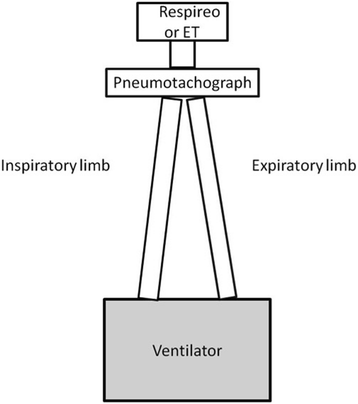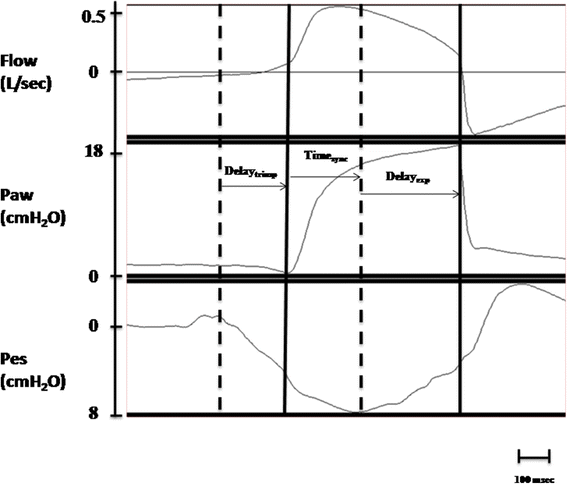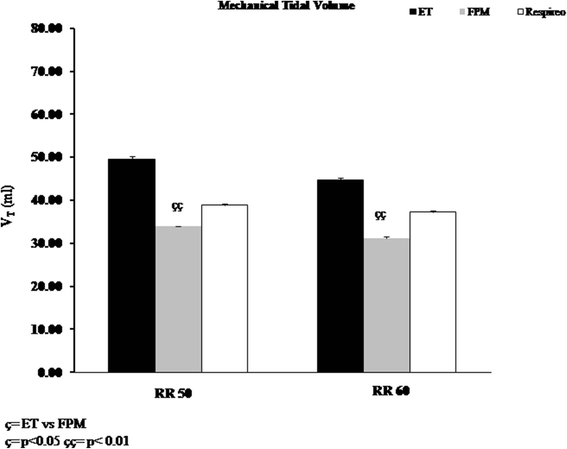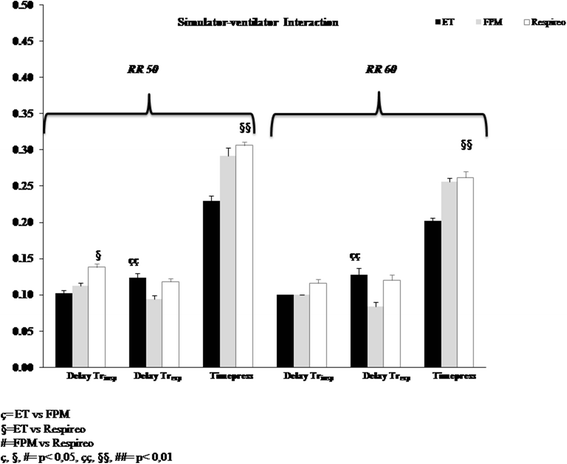Comparative bench study evaluation of different infant interfaces for non-invasive ventilation
- PMID: 29625596
- PMCID: PMC5889592
- DOI: 10.1186/s12890-018-0620-x
Comparative bench study evaluation of different infant interfaces for non-invasive ventilation
Abstract
Background: To compare, in terms of patient-ventilator interaction and performance, a new nasal mask (Respireo, AirLiquide, FR) with the Endotracheal tube (ET) and a commonly used nasal mask (FPM, Fisher and Paykel, NZ) for delivering Pressure Support Ventilation (PSV) in an infant model of Acute Respiratory Failure (ARF).
Methods: An active test lung (ASL 5000) connected to an infant mannequin through 3 different interfaces (Respireo, ET and FPM), was ventilated with a standard ICU ventilator set in PSV. The test lung was set to simulate a 5.5 kg infant with ARF, breathing at 50 and 60 breaths/min). Non-invasive ventilation (NIV) mode was not used and the leaks were nearly zero.
Results: The ET showed the shortest inspiratory trigger delay and pressurization time compared to FPM and Respireo (p < 0.01). At each respiratory rate tested, the FPM showed the shortest Expiratory trigger delay compared to ET and Respireo (p < 0.01). The Respireo presented a lower value of Inspiratory pressure-time product and trigger pressure drop than ET (p < 0.01), while no significant difference was found in terms of pressure-time product at 300 and 500 ms. During all tests, compared with the FPM, ET showed a significantly higher tidal volume (VT) delivered (p < 0.01), while Respireo showed a trend toward an increase of tidal volume delivered compared with FPM.
Conclusions: The ET showed a better patient-ventilator interaction and performance compared to both the nasal masks. Despite the higher internal volume, Respireo showed a trend toward an increase of the delivered tidal volume; globally, its efficiency in terms of patient-ventilator interaction was comparable to the FPM, which is the infant NIV mask characterized by the smaller internal volume among the (few) models on the market.
Keywords: Acute respiratory failure; Bench test; Infant mask; Mechanical ventilation; Non invasive ventilation; Patient-ventilator interaction.
Conflict of interest statement
Ethics approval and consent to participate
Not applicable
Consent for publication
Not applicable
Competing interests
All authors declare that they have no competing interests.
Publisher’s Note
Springer Nature remains neutral with regard to jurisdictional claims in published maps and institutional affiliations.
Figures





Similar articles
-
Influence of different interfaces on synchrony during pressure support ventilation in a pediatric setting: a bench study.Respir Care. 2015 Apr;60(4):498-507. doi: 10.4187/respcare.03309. Epub 2015 Jan 20. Respir Care. 2015. PMID: 25605957
-
Neurally-Adjusted Ventilatory Assist for Noninvasive Ventilation via a Helmet in Subjects With COPD Exacerbation: A Physiologic Study.Respir Care. 2019 May;64(5):582-589. doi: 10.4187/respcare.06502. Epub 2019 Feb 12. Respir Care. 2019. PMID: 30755472 Clinical Trial.
-
A bench study of 2 ventilator circuits during helmet noninvasive ventilation.Respir Care. 2013 Sep;58(9):1474-81. doi: 10.4187/respcare.02060. Epub 2013 Feb 19. Respir Care. 2013. PMID: 23431311
-
Noninvasive Ventilation.Clin Chest Med. 2016 Dec;37(4):711-721. doi: 10.1016/j.ccm.2016.07.011. Epub 2016 Sep 10. Clin Chest Med. 2016. PMID: 27842751 Review.
-
Noninvasive ventilation for acute respiratory failure.Respir Care. 2013 Jun;58(6):950-72. doi: 10.4187/respcare.02319. Respir Care. 2013. PMID: 23709194 Review.
Cited by
-
Tidal Volume Estimation during Helmet Noninvasive Ventilation: an Experimental Feasibility Study.Sci Rep. 2019 Nov 21;9(1):17324. doi: 10.1038/s41598-019-54020-5. Sci Rep. 2019. PMID: 31754262 Free PMC article.
-
Nasal Cannula with Long and Narrow Tubing for Non-Invasive Respiratory Support in Preterm Neonates: A Systematic Review and Meta-Analysis.Children (Basel). 2022 Sep 23;9(10):1461. doi: 10.3390/children9101461. Children (Basel). 2022. PMID: 36291395 Free PMC article. Review.
-
Interfaces, Circuits and Humidifiers.Front Pediatr. 2020 Dec 7;8:557301. doi: 10.3389/fped.2020.557301. eCollection 2020. Front Pediatr. 2020. PMID: 33365289 Free PMC article. Review.
References
-
- Yanez LJ, Yunge M, Emilfork M, Lapadula M, Alcantara A, Fernandez C, Lozano J, Contreras M, Conto L, Arevalo C, Gayan A, Hernandez F, Pedraza M, Feddersen M, Bejares M, Morales M, Mallea F, Glasinovic M, Cavada G. A prospective, randomized, controlled trial of noninvasive ventilation in pediatric acute respiratory failure. Pediatr Crit Care Med. 2008;9:484–489. doi: 10.1097/PCC.0b013e318184989f. - DOI - PubMed
Publication types
MeSH terms
LinkOut - more resources
Full Text Sources
Other Literature Sources
Medical

